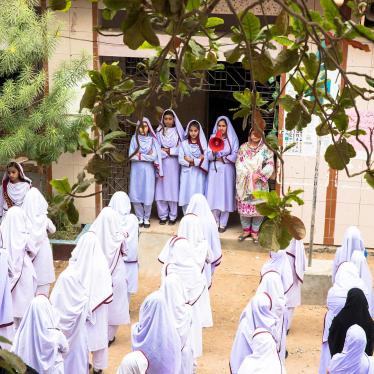A ground-breaking new report by Human Rights Watch, No Escape: Male Rape in U.S. Prisons, charges that state authorities are responsible for widespread prisoner-on-prisoner sexual abuse in U.S. men's prisons.
"Rape is in no way an inevitable consequence of incarceration," said Joanne Mariner, deputy director of the Americas division of Human Rights Watch, and author of the report. "But it is a predictable one if prison and prosecutorial authorities do little to prevent and punish it."
Human Rights Watch warned that by failing to implement reasonable measures to prevent and punish rape—and, indeed, in many cases, taking actions that make sexual victimization likely—state authorities permit this physically and psychologically devastating abuse to occur. The group's findings are based on correspondence with more than 200 prisoners spread among thirty-four states, inmate interviews, and a comprehensive survey of state correctional authorities.
Certain prisoners are targeted for sexual exploitation the moment they enter a penal facility: their age, looks, sexual orientation, and other characteristics mark them as candidates for abuse. Human Rights Watch's research revealed a broad range of factors that correlate with increased vulnerability to rape. These include youth, small size, and physical weakness; being white, gay, or a first offender; possessing "feminine" characteristics such as long hair or a high voice; being unassertive, unaggressive, shy, intellectual, not street-smart, or "passive"; or having been convicted of a sexual offense against a minor.
Sexual Slavery
In the most extreme cases, Human Rights Watch found that prisoners unable to escape a situation of sexual abuse may find themselves the "slaves" of their rapists. Forced to satisfy another man's sexual appetites whenever he demands, they may also be responsible for washing his clothes, massaging his back, cooking his food, cleaning his cell, and a range of other chores. They are frequently "rented out" for sex, sold, or even auctioned off to other inmates.
No conclusive national data exist regarding the prevalence of prisoner-on-prisoner rape in the United States. But the most recent statistical survey, published in the Prison Journal, showed that 21 percent of inmates in seven Midwestern prisons had experienced at least one episode of pressured or forced sex since being incarcerated, and at least 7 percent had been raped in their facility. And an internal departmental survey of corrections officers in one southern state found that line officers ?those charged with the direct supervision of inmates ?estimated that roughly one-fifth of all prisoners were being coerced into participation in inmate-on-inmate sex.
"These rapes are unimaginably vicious and brutal," said Mariner. "Gang assaults are not uncommon, and victims may be left beaten, bloody and, in the most extreme cases, dead."
One of the most tragic and violent cases the report documents is that of Randy Payne, a twenty-three-year-old incarcerated in Texas. Within a week of entering prison, Payne was attacked by a group of some twenty inmates. The inmates demanded sex and money, but Payne refused. He was beaten for almost two hours, and died of head injuries a few days later.
Victims of rape often suffer extreme psychological stress, a condition identified as "rape trauma syndrome." Many inmate victims with whom Human Rights Watch has been in contact have reported nightmares, deep depression, shame, loss of self-esteem, self-hatred, and considering or attempting suicide.
"Deliberate Indifference"
Correctional authorities generally deny that prisoner-on-prisoner rape is a serious problem. Human Rights Watch surveyed correctional authorities in all 50 states on the prevalence of rape and sexual abuse. In that multi-year survey, not one state reported abuse rates even faintly approaching those found by academic researchers. For example, New Mexico prison officials said, regarding "the ‘problem' of male inmate-on-inmate rape and sexual abuse" (internal quotation marks are theirs), that they had "no recorded incidents over the past few years." Nearly half of all states do not even compile separate statistics on sexual assault.
The authorities' reluctance to acknowledge the problem of prisoner-on-prisoner rape is reflected not only in misleading official statistics, but also in a glaringly inadequate response to incidents of rape. "U.S. state prisons have failed to take even obvious, basic steps necessary to tackle prison rape," Mariner said. "This deliberate indifference has had tragic consequences."
A central problem is the deficient ?and, in many instances, callous and irresponsible ?response of correctional staff to complaints of rape. When an inmate informs an officer he has been threatened with rape or, worse, actually assaulted, it is crucial that his complaint be investigated and that he be protected from further abuse. Yet Human Rights Watch found that correctional staff frequently ignore or even react hostilely to inmates' complaints of rape.
"Another important contributing factor to the prison rape crisis is the failure of the criminal justice system to address these crimes," said Mariner. "Perpetrators of prison rape rarely face criminal charges, even when rape is accompanied by extreme physical violence."
The case of M.R., a Texas inmate, is illustrative. M.R. was violently raped and beaten several times over a period of several months by the same prisoner. Fearful for his life, he reported the abuse to the prison authorities, but found no protection. In fact one investigator dismissed the problem as a "lovers' quarrel." Finally one day the rapist showed up in M.R.'s housing area and attacked M.R. again. The rapist hit M.R. so hard with a combination lock that when M.R. regained consciousness he could read the word "Master" ?the lockmaker ?on his forehead. In all, during the rape, M.R. suffered a broken neck, jaw, left collarbone, and finger; a dislocated left shoulder; two major concussions, and lacerations to his scalp that caused bleeding on the brain. Notwithstanding the extreme violence of the attack, and despite M.R.'s best efforts to press charges, the rapist was never criminally prosecuted.
Another devastating consequence of prisoner-on-prisoner rape discussed in the report is the transmission of the HIV virus. Several prisoners with whom Human Rights Watch is in contact believe that they have contracted HIV, the virus that causes AIDS, through forced sexual intercourse in prison.
The book-length Human Rights Watch report explains:
- why and how prisoner-on-prisoner sexual abuse occurs;
- who commits it and who falls victim to it;
- prison rape's long-term effects, both physical and psychological;
- how are prison authorities coping with it; and
- what reforms must be instituted to better prevent rape from occurring.
"Prison rape is part of the mythology of prison life. But in reality, it is devastating human rights abuse that can and should be prevented," said Mariner. The report includes extensive recommendations to federal and state authorities, urging them to step up their efforts to address this gross violation of human dignity.







